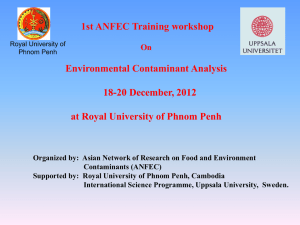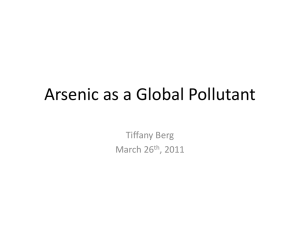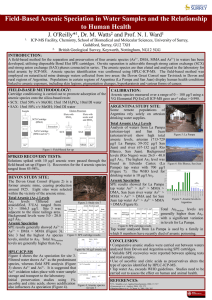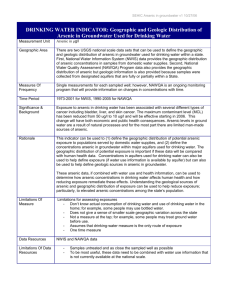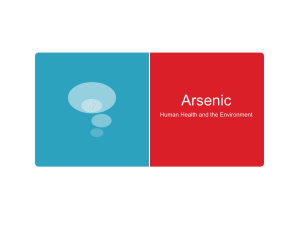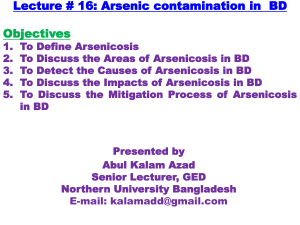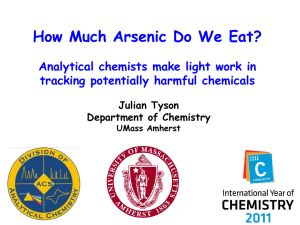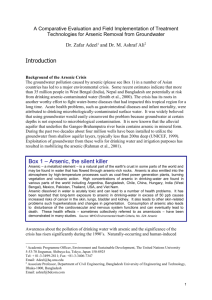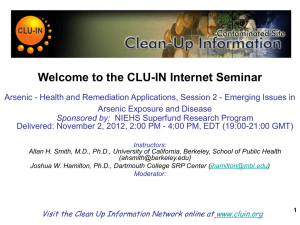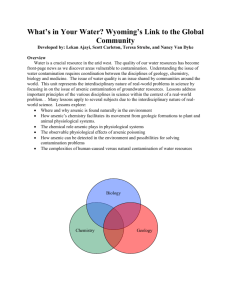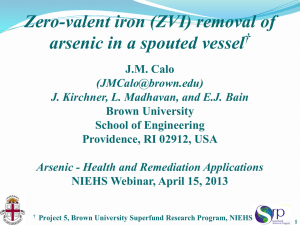Exposure to Inorganic Arsenic Metabolites during Early Human
advertisement
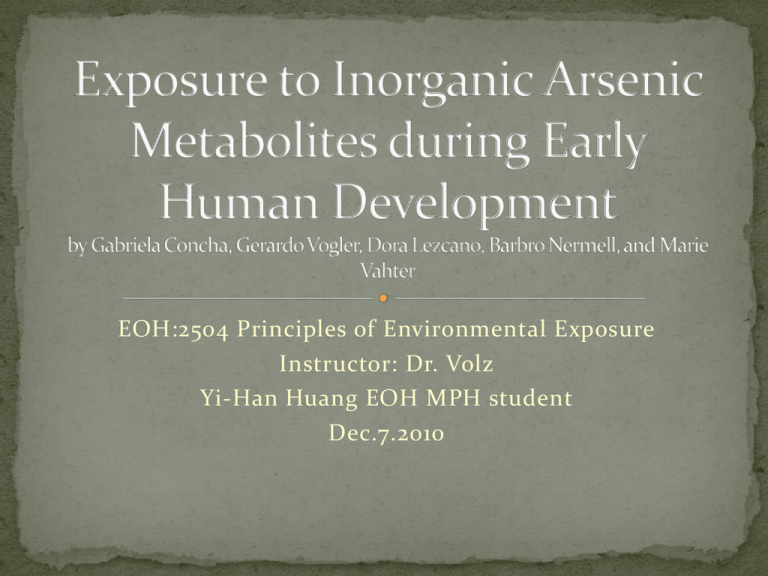
EOH:2504 Principles of Environmental Exposure Instructor: Dr. Volz Yi-Han Huang EOH MPH student Dec.7.2010 Introduction Material and Method Results Conclusion Introduction Why inorganic arsenic? Arsenic exposure via drinking water has been associated with cancer of the skin and various internal organs. High doses of arsenite or arsenate to rodents prior to or during organogenesis results in multiple malformations, decrease prenatal growth rate, and increased mortality. Why prenatal? In a couple of studies, prenatal exposure to acute and very high dose of arsenic has resulted in miscarriage and early neonatal death. Malformations, spontaneous abortions, and low birth weights has been observed among children of female employees in a copper smelter, but due to the multiple chemical exposure the role of arsenic is not clear. There are a few reports indicating associations between adverse reproductive outcome and exposure to arsenic in drinking water, however, the causal relationship is not well ascertained. In women without known exposure to arsenic, the concentration of arsenic in cord blood was similar to that in maternal blood (Kagey et al., 1977), however, the form of arsenic in blood was not determined. The main exposure form of arsenic in blood is arsenobetaine, which can be present in high concentration in seafood. We have recently reported on high concentrations of arsenic in blood and urine of native Andean women and children living in an area in Northern Argentina with about 200 μg As/liter in the drinking water. The aim of the study was to investigate exposure to arsenic during early development by comparing concentrations and patterns of arsenic metabolites in cord blood and infant urine with those of maternal blood and urine. Material and methods Location San Antonio de los Cobres, in the western part of the Salta province in northern Argentina. Population about 4000 inhabitants. (Andean) Geology Volcanic bedrock (arsenic) Groundwater contained 200 μg/liter Nutritional mainly of animal origin (meat, milk products, but essentially no fish), vegetables and rice. Collected data: For investigation of arsenic exposure, samples of material blood and urine were collected before delivery, cord blood and placenta were collected at delivery, and samples of maternal blood, urine, and breast milk were collected at an average of 2.8 weeks, 2.5 months, and 4.4 months after delivery. Infant urine were collected a few days after birth, 2.8 weeks, 2.5 months and 4.4 months. Interviews Time of residence in the area as well as the source of drinking water, water consumption and dietary habits. Examine The conc. Of total arsenic in blood, urine, and milk were determined by using hydride generation atomic absorption spectrophotometry (HG-AAS) The sum of the metabolites of inorganic arsenic in the urine samples was determined using direct HG-AAS. Statistics Spearman rank order correlation test, and Pearson product moment correlation were used. Results Discussion Cord blood The concentrations of arsenic in cord blood, 9.2 μg/liter on average, were about as high as in maternal blood just before delivery. This shows that arsenic is readily transferred across the placenta to the fetus. DMA All arsenic in maternal and cord plasma was in the form of DMA, the end product of inorganic arsenic metabolism. DMA in maternal urine in late gestation and first infant urine was significantly higher than in the postpartum period. DMA (continued) The results indicate that arsenic methylation increases during pregnancy and that DMA is the main form of arsenic being transferred to the fetus. Previous studies indicates that the children excrete less DMA in the urine, they are more sensitive to arsenicinduced toxicity than are the adults. If so , the increased arsenic methylation during pregnancy is highly protective for the developing organism. DMA (continued) DMA has a higher rate of excretion and lower tissue retention than inorganic arsenic, however, the mechanism of the increased arsenic methylation is not clear. Excrete MMA and DMA in urine, giving strong support for methylation being an enzymatic process also in humans. If so, the results indicate an induction of the arsenite methylation. Arsenic The median arsenic conc. In placenta was 34 μg/kg, about 3 times the blood conc. The effect of arsenic accumulation on placental function is not known. Despite the high arsenic conc. in maternal blood and urine, the conc. in maternal milk was low, this is similar to a previous finding on arsenic conc. in maternal milk. Maternal milk The highest U-Asmet conc. were detected in three infants who were given formula in addition to breast milk. 3 μg arsenic per day, while formula prepared from the local water would provide about 200 μg arsenic/day. Thus, the low content of arsenic in maternal milk is an additional important reason for long breastfeeding periods in areas with high arsenic exposure. Thank you for your listening!

